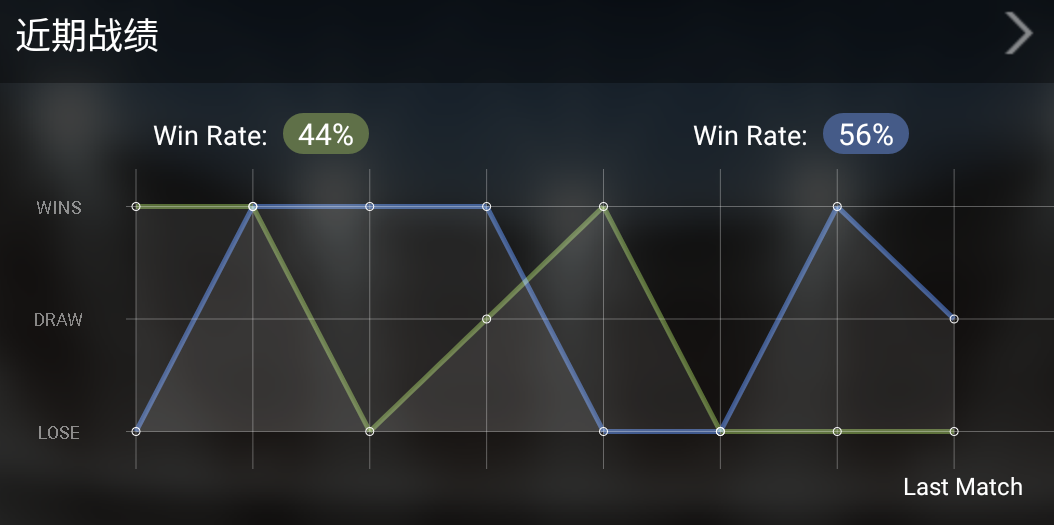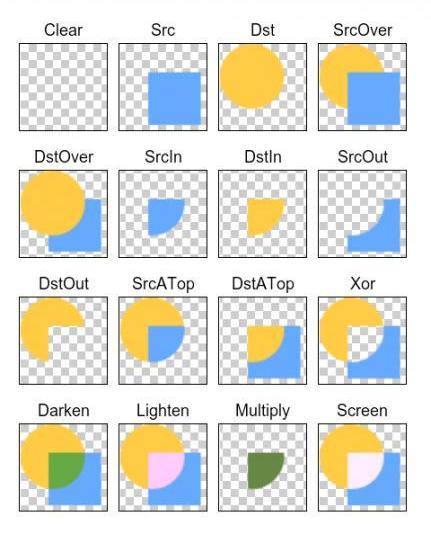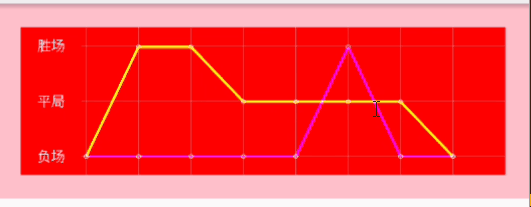編輯:關於Android編程
實現一個如下圖所示的折線圖



首先是控件繪圖區域的劃分,控件左邊取一小部分(控件總寬度的八分之一)繪制表頭,右邊剩余的部分繪制表格
確定表格的行列數,首先繪制一個三行八列的網格,設置好行列的坐標後開始繪制
/*繪制三條橫線*/ for(int i=0;i<3;i++){ canvas.drawLine(textWide, mLineYs[i], totalWidth, mLineYs[i], mPaintLine); } /*繪制八條豎線*/ for(int i=0;i<8;i++){ canvas.drawLine(mLineXs[i], 0, mLineXs[i], totalHeight, mPaintLine); }
網格繪制完成後,開始繪制折線圖
根據輸入的節點數據,分別繪制兩條折線
通過canvas的drawLine方法依次連接兩點即可
在每個數據節點處繪制一個小圓,突出顯示
/*繪制第一條折線的路徑*/
for (int i = 0; i < mPerformance_1.length - 1; i++) {
/*折線圖的折線的畫筆設置粗一點*/
mPaintLine.setStrokeWidth(5);
/*計算當前節點的坐標值*/
float prePointX =mLineXs[i];
float prePointY =mLineYs[2] - (mLineYs[2] - mLineYs[mPerformance_1[i].type]) * animCurrentValue;
/*計算下一個節點的坐標值*/
float nextPointX=mLineXs[i + 1];
float nextPointY=mLineYs[2] - (mLineYs[2] - mLineYs[mPerformance_1[i + 1].type]) * animCurrentValue;
/*連接當前坐標和下一個坐標,繪制線段*/
canvas.drawLine(prePointX, prePointY, nextPointX, nextPointY, mPaintLine1);
/*當前節點坐標處繪制小圓*/
canvas.drawCircle(prePointX, prePointY, mSmallDotRadius, mPointPaint);
}
兩條折線重合的地方,需要特殊考慮,比如希望兩條折線重合的地方折線變為白色
設置下兩條折線的畫筆即可
mPaintLine2.setXfermode(new PorterDuffXfermode(PorterDuff.Mode.SCREEN)); mPaintLine1.setXfermode(new PorterDuffXfermode(PorterDuff.Mode.SCREEN));

測試代碼及效果;
final Random random=new Random();
final LineChartView myView=(LineChartView)findViewById(R.id.custom_view);
final LineChartView.Performance[] performances1=new LineChartView.Performance[8];
final LineChartView.Performance[] performances2=new LineChartView.Performance[8];
myView.setOnClickListener(new View.OnClickListener(){
@Override
public void onClick(View v){
for(int i=0;ilength;i++){
switch (random.nextInt(2016)%3){
case 0:
performances1[i]= LineChartView.Performance.WIN;
break;
case 1:
performances1[i]= LineChartView.Performance.DRAW;
break;
case 2:
performances1[i]= LineChartView.Performance.LOSE;
break;
default:
performances1[i]= LineChartView.Performance.LOSE;
break;
}
switch (random.nextInt(2016)%3){
case 0:
performances2[i]= LineChartView.Performance.WIN;
break;
case 1:
performances2[i]= LineChartView.Performance.DRAW;
break;
case 2:
performances2[i]= LineChartView.Performance.LOSE;
break;
default:
performances1[i]= LineChartView.Performance.LOSE;
break;
}
}
myView.setPerformances(performances1,performances2);
}
});

完整代碼如下:
public class LineChartView extends View {
private Context context;
/*動畫插值器*/
DecelerateInterpolator mDecelerateInterpolator = new DecelerateInterpolator();
/*動畫刷新的次數*/
private int mDuration = 10;
/*當前動畫進度值*/
private int mCurrentTime = 0;
private Performance[] mPerformance_1, mPerformance_2;
/*兩條折線的顏色*/
private int mLineColor1, mLineColor2;
/*繪制表頭文字畫筆*/
private Paint mPaintText = new Paint();
/*繪制表格的畫筆*/
private Paint mPaintLine = new Paint();
/*第一條折線的畫筆*/
private Paint mPaintLine1 =new Paint();
/*第二條折線的畫筆*/
private Paint mPaintLine2 =new Paint();
/*坐標點的小圓點畫筆*/
private Paint mPointPaint = new Paint();
private float mSmallDotRadius = 4;
private TypedValue typedValue;
private int mPaintClolor;
/*Handler刷新界面產生動畫效果*/
private Handler mHandler = new Handler();
private Runnable mAnimation = new Runnable() {
@Override
public void run() {
if (mCurrentTime < mDuration) {
mCurrentTime++;
LineChartView.this.invalidate();
}
}
};
public LineChartView(Context context) {
super(context);
this.context=context;
init();
}
public LineChartView(Context context, AttributeSet attrs) {
super(context, attrs);
this.context=context;
init();
}
public LineChartView(Context context, AttributeSet attrs, int defStyleAttr) {
super(context, attrs, defStyleAttr);
this.context=context;
init();
}
public enum Performance {
WIN(0),
DRAW(1),
LOSE(2);
public int type;
Performance(int type) {
this.type = type;
}
}
public void setPerformances(Performance[] performance1, Performance[] performance2) {
if (performance1 == null) {
performance1 = new Performance[0];
}
if (performance2 == null) {
performance2 = new Performance[0];
}
mPerformance_1 = Arrays.copyOf(performance1, performance1.length > 8 ? 8 : performance1.length);
mPerformance_2 = Arrays.copyOf(performance2, performance2.length > 8 ? 8 : performance2.length);
if (isShown()) {
mCurrentTime = 0;
this.invalidate();
}
}
/**
* 設置折線1的顏色
*
* @param mLineColor1
*/
public void setLineColor1(int mLineColor1) {
this.mLineColor1 = mLineColor1;
}
/**
* 設置折線2的顏色
*
* @param mLineColor2
*/
public void setLineColor2(int mLineColor2) {
this.mLineColor2 = mLineColor2;
}
private void init() {
mLineColor1=Color.BLUE;
mLineColor2 = Color.GREEN;
typedValue=new TypedValue();
context.getTheme().resolveAttribute(R.attr.title_bar,typedValue,true);
mPaintClolor =getResources().getColor(typedValue.resourceId);
final LineChartView.Performance[] performances1=new LineChartView.Performance[8];
final LineChartView.Performance[] performances2=new LineChartView.Performance[8];
final Random random=new Random();
for(int i=0;i
 給Android的APK程序簽名和重新簽名的方法
給Android的APK程序簽名和重新簽名的方法
簽名工具的使用Android源碼編譯出來的signapk.jar既可給apk簽名,也可給rom簽名的。使用格式:java –jar signapk.jar [-w] pu
 Android自定義(三)實現圓盤的百分比設置
Android自定義(三)實現圓盤的百分比設置
最近一直在學習自定義控件,昨天看到群裡有人問如何如何實現圓盤樣式的顯示,學有所用,於是乎就有了這篇博客 先上圖,一目了然 這裡的顯示顏色以及顏色塊的大小你都可以自己設置
 詳解Android N適配要點
詳解Android N適配要點
Google即將發布的Android7.0的預覽版Android_N為我們增加了許多新的特性,其中包括多窗口的支持、通知欄支持直接回復、網絡數據節省開關、以及新的DOZE
 Android入門之AlertDialog用法實例分析
Android入門之AlertDialog用法實例分析
本文實例講述的是AlertDialog,這種對話框會經常遇到。AlertDialog跟WIN32開發中的Dialog不一樣,AlertDialog是非阻塞的,而阻塞的對話